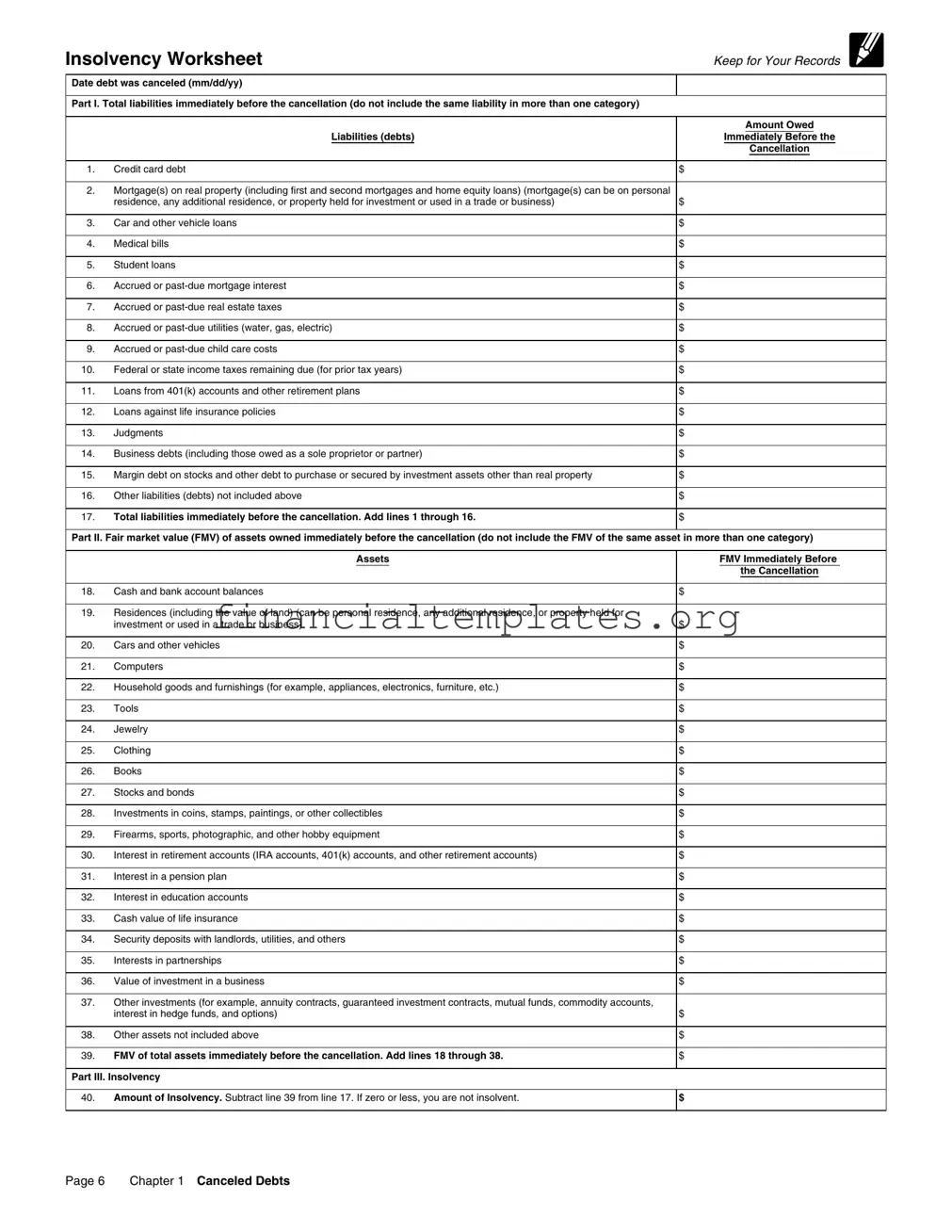The Form 1040, U.S. Individual Income Tax Return, bears a resemblance to the Insolvency IRS form because it also requires taxpayers to declare various types of income, deductions, and credits. Much like how the insolvency form calculates a taxpayer's financial status by comparing liabilities and assets, Form 1040 assesses an individual's tax liability based on their annual income and allowable deductions, influencing their tax standing with the Internal Revenue Service.
The Schedule C (Form 1040), Profit or Loss from Business, is similar to the insolvency form in that it also deals with assessing financial health, albeit from a business perspective. Schedule C requires the declaration of income and expenses related to business activities, which directly affects the taxpayer's overall financial position, much like the insolvency form's aim to establish a person's financial situation by listing personal liabilities and assets.
The Schedule D (Form 1040), Capital Gains and Losses, shares commonalities with the insolvency form, particularly in the way it addresses the financial implications of investments. While the insolvency form includes assessments of investments such as stocks, bonds, and other securities, Schedule D is specifically designed to report gains or losses from such investments, impacting the taxpayer's financial situation.
The Form 982, Reduction of Tax Attributes Due to Discharge of Indebtedness, directly relates to the insolvency form as it is used when a taxpayer excludes canceled debt from income due to insolvency or other exclusions. This form helps taxpayers reduce certain tax attributes and adjust basis in assets, paralleling the insolvency form's goal of evaluating financial condition in light of debt cancellation.
The Estate Tax Return (Form 706) parallels the Insolvency IRS Form in its approach to valuing assets and liabilities, but within the context of an individual's estate following their death. Both forms require detailed listings of values, though for different purposes: estate tax liability versus determining insolvency status.
The Form 433-A, Collection Information Statement for Wage Earners and Self-Employed Individuals, is conceptually similar to the insolvency form because both require the individual to provide comprehensive details about their financial situation. This includes income, living expenses, assets, and liabilities, aimed at assessing ability to pay tax debt or negotiate payment plans.
The Bankruptcy Forms, used when filing for bankruptcy protection, have a notable similarity with the insolvency form, focusing on a thorough declaration of the debtor’s assets, liabilities, income, and expenses. This comprehensive financial snapshot is crucial for both determining insolvency and guiding the bankruptcy process to manage and discharge debts.
The Form 656, Offer in Compromise, shares a common goal with the insolvency form in that it is designed to help individuals settle tax debts for less than the full amount owed based on an inability to pay. Both forms take into account the taxpayer's financial situation, including assets and liabilities, to evaluate the viability of reducing debt obligations.
The Statement of Financial Affairs for Individuals Filing for Bankruptcy requires debtors to list all significant financial actions, income sources, and properties, akin to the detailed asset and liability listings on the insolvency worksheet. This parallels the need in both documents to provide a comprehensive view of an individual's financial standing to assess their capacity to meet debt obligations.
Lastly, the Annual Information Return of Foreign Trust with a U.S. Owner (Form 3520-A) indirectly relates to the insolvency form by requiring detailed information on trust assets, which could influence a U.S. owner's financial position and potentially their insolvency status. Although focused on foreign trusts, the underlying principle of disclosing assets to evaluate financial health aligns with the purpose of the insolvency form.

